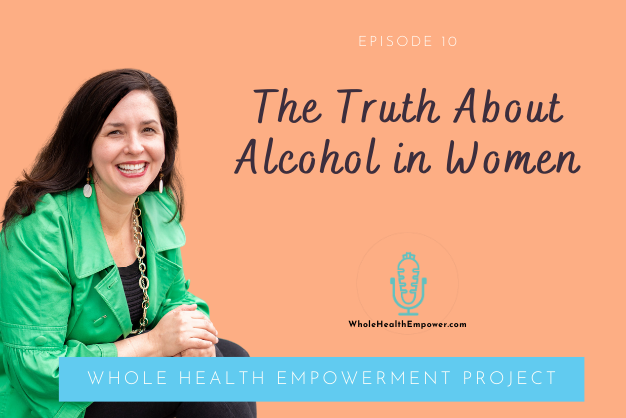Let’s dig into the topic of alcohol use in women, how alcohol works differently in women, what is moderate consumption, and tips to decrease consumption.
Episode Resources:
The Truth About Alcohol in Women
by Tricia Stefankiewicz, MA RDN
In doing research for other topics, I came across some statistics and information about alcohol use among women that I wanted to explore. Mainly, the science behind the difference between consumption in women and men, what is considered moderate intake, benefit and risks of consuming alcohol, and some strategies to decrease intake.
Over my lifetime, my relationship and opinion of alcohol has changed from one of pleasure and increased socialization to recognizing the devastation it can cause loved ones when abused. Growing up, my parents didn’t drink much alcohol beyond the intermittent parties and social gatherings they attended, and alcohol wasn’t an everyday exposure in our home. As I went to high school and college, I began to have much more of an introduction to drinking in social setting among friends and how fun and emboldened I felt when I consumed alcohol. I have had seasons when I didn’t drink at all and other times when I felt that I was drinking more than what I felt was good for me and my body. As I entered, my thirties, I found myself consuming more alcohol that I had ever before. As I was yet unmarried and not yet a parent, my social circle and events were centered around eating out and drinking alcohol at least 3-4 nights per week if not more. I had a feeling my intake was beyond moderate and would find myself “googling” questions like “how many drinks per week is too much. Sometimes I would try to figure out how many drinks I would allow myself to have this week and then count throughout the week to see if I exceeded this amount. The consequences of alcohol overuse and abuse became clear to me when a close person in my life was admitted to rehab for alcohol addiction. The emotional and financial impact that it had on my life forever changed the way I thought about alcohol. It was no longer a harmless, fun behavior but instead one of destruction with long lasting devastation. Ultimately, it made me revisit my relationship with alcohol and how I could create more balance and moderate with alcohol in my own life.
I had always thought that alcohol had some health benefit, so I wanted to explore to see if that was true. First, let me share some statistics I found in my research: alcohol abuse is rising in women; the benefit of alcohol intake on our health occurs only when consumed in moderation, that benefit becomes harmful as the level of alcohol consumed increased.
The Centers for Disease Control and Prevention (CDC) report:
- Approximately 46% of adult women report drinking alcohol in the last 30 days.
- Approximately 12% of adult women report binge drinking 3 times a month, averaging 5 drinks per binge.
- Most (90%) people who binge drink are not alcoholics or Alco dependent.
- About 2.5% of women and 4.5% of men met the diagnostic criteria for alcohol dependence in the past year.
Why is this topic important? I feel like we all tout this idea that alcohol is beneficial for us because of its possibility of decreasing heart disease risk. Certainly, the Mediterranean diet, which is lauded for its health benefits, includes red wine. The caveat though is that it occurs with moderate consumption of red wine, which is 1 glass per day for women. Excessive intake has been shown to cause harm and no longer provides that same benefit.
Alcohol is metabolized differently in women and men due to differences in body composition and chemical makeup. In general, women’s bodies are made up of less water than in men. Women have more fat, for childbearing purposes, and therefore are made up of less water. Men on the other hand, have more lean tissue, which has more water. The more water a person has, the more freely the alcohol can more around and circulate; whereas the more fat you have means the alcohol gets confined to this space. This causes alcohol to remain in the space and process the alcohol at a slower rate. Thus, if a man and woman of the same weight drink the same amount of alcohol, the woman will absorb more alcohol, have a higher blood alcohol content, and the alcohol effect will occur quicker and last longer. In addition, women have fever enzymes that help metabolize and break down alcohol in the body.
What are the Recommendations for women and how much is too much?
The 2015-2020 U.S. Dietary Guidelines for Americans recommends that if alcohol is consumed, it should be consumed in moderation. What is moderation and how much is too much?
Moderate drinking: one drink per day for women and two drinks per day for men
Heavy drinking: 8 drinks or more per week for women
Binge drinking: 4 or more drinks on a single occasion within 2 hours for women
What is one drink/what counts as a serving size:
- 12 ounces of 5% beer
- 8 ounces of 7% malt liquor
- 5 ounces of 12% wine
- 1.5 ounces (80 proof) of distilled spirits or liquor like vodka or rum
What are the benefits/harm of alcohol consumption?
Benefit
- Decrease in heart disease
- Seen only with moderate alcohol intake, 1 drink per day
Harm
- Can be seen with both short and long term when drinking too much on a single occasion or over time
Short term:
- slurred speech
- memory impairment
- Increase in risky and harmful behavior such as motor vehicle crashes
- Increase in depression
Long term:
- Heart disease
- Alcoholic hepatitis and cirrhosis of the liver (scarring of the liver and its inability to regenerate and form new cells as alcohol is metabolized in the liver)
- Pancreatitis
- Strong association between and increased risk of cancers including head and neck, esophageal, liver, breast, and colorectal.
- Increased risk of getting sick with lower immunity
- Weight gain. Contrary to the myth that some kinds of liquor does not have calories. All liquor has calories. Most alcohol has at least ~ 100 calories per serving. More calories can be seen with mixing in juice or regular soda. Tropical, sugary drinks such as a daiquiri or pina colada has more calories. Refer to the link above to see how many calories is in your favorite drink: rethinking drinking: alcohol calorie calculator
The above consequences occur in both men and women. Of those, women are at an increased risk then men for heart disease, alcohol hepatitis, breast cancer, and brain damage.
One study suggests that “the risk of these consequences increase with more alcohol consumption even at very low levels of alcohol consumption (less than 1 drink).”
Who should avoid alcohol intake?
- Women who are or may be pregnant.
- People younger than age 21.
- People who have certain medical conditions or are taking certain medications that can interact with alcohol such as sedative drugs, sleeping pills, pain relievers, and anti-anxiety medications
- Recovering alcoholics or people unable to control the amount they drink.
- People who are doing things that require skill, coordination, and alertness, such as driving a car
- Women who are breastfeeding should talk with their health care provider about alcohol consumption. Not drinking alcohol is the safest option for breastfeeding mothers. Generally, moderate alcohol consumption by a breastfeeding mother (up to 1 standard drink per day) is not known to be harmful to the infant, especially if the mother waits at least 2 hours after a single drink before nursing. However, exposure to alcohol above moderate levels through breast milk could be damaging to an infant’s development, growth, and sleep patterns. (CDC)
- Note that if you don’t currently drink, it is not recommended that you start to get the health benefit
Now that we understand more about alcohol and women, let talk about some tips to moderate intake
- Don’t drink on an empty stomach, eating will help slow absorption
- Start your first drink with a non-alcoholic beverage
- Alternate between alcoholic and non-alcohol drinks
- Choose lower calorie options or turn your drink into a spritzer
- Have “days off” when you don’t drink at all
- Consume a smaller amount or a lower alcohol content beverage
Think about how you feel when you consume too much alcohol. How would you feel if you cut down? Would you have more energy, better sleep, less depression, anxiety, better weight control, better immunity? Recognize this.
In conclusion, having an occasional few drinks on a night out with friends or while you are on vacation isn’t as concerning as consistent prolonged “more than moderate” alcohol use. The health benefit of alcohol is with moderate consumption, not with overconsumption. Make small changes that will lead you to your eventual goal. It’s not about being perfect, it’s about being 1% better each day. Be kind to yourself friends.
If you are concerned that either you or someone you love might have a drinking problem, consult your personal health care provider. I have also attached resources for you to refer to.
https://www.cdc.gov/alcohol/fact-sheets/womens-health.htm
https://www.niaaa.nih.gov/sites/default/files/women-and-alcohol-fact-sheet.pdf
https://www.cdc.gov/alcohol/faqs.htm#excessivealcohol
https://www.niaaa.nih.gov/alcohol-health/overview-alcohol-consumption/alcohol-use-disorders
https://www.cdc.gov/alcohol/fact-sheets/moderate-drinking.htm
https://health.gov/our-work/food-nutrition/2015-2020-dietary-guidelines/guidelines/appendix-9/
https://www.niaaa.nih.gov/alcohols-effects-health/alcohols-effects-body
https://www.rethinkingdrinking.niaaa.nih.gov/
https://www.samhsa.gov/find-help/national-helpline

